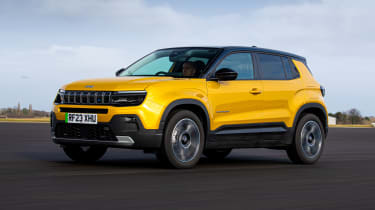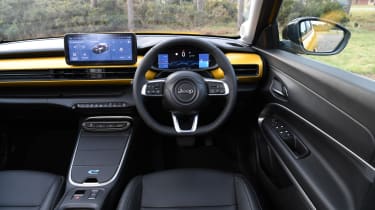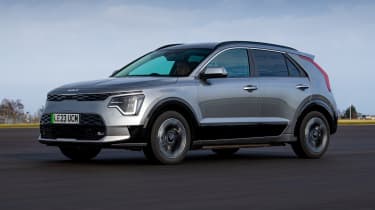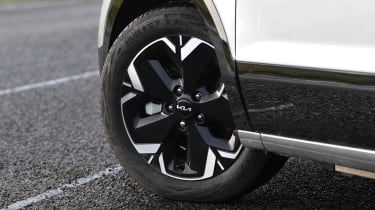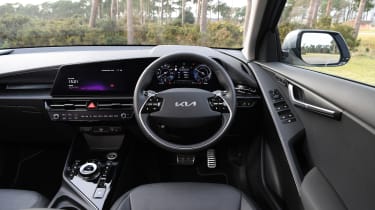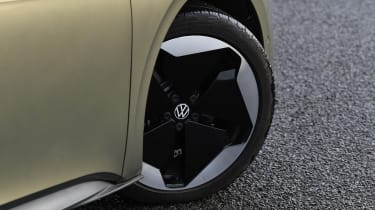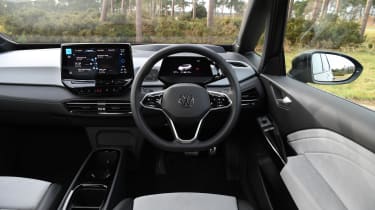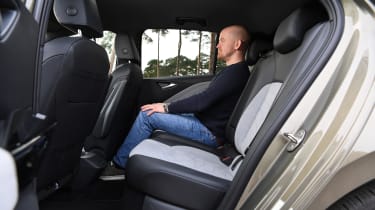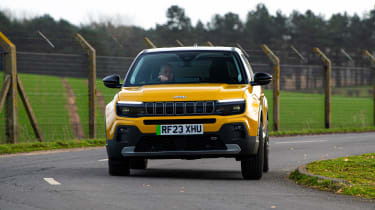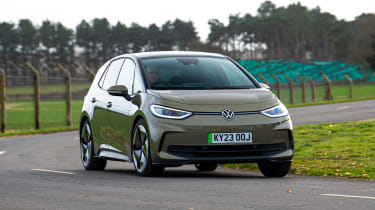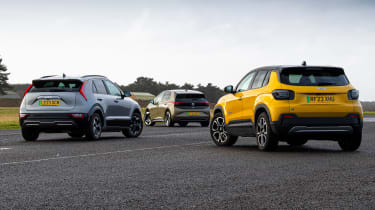Jeep Avenger vs Kia Niro EV vs Volkswagen ID.3: low-cost compact EVs duke it out
Electric car prices are already being slashed to meet new sales targets. We line up Jeep, Kia and VW rivals to see what’s on offer
Government policy has the potential to play a massive role in 2024’s new-car market. The Zero Emission Vehicle (ZEV) mandate has come into effect, which means that manufacturers need to ensure that at least 22 per cent of the cars they sell will be fully-electric. And we’re already seeing evidence that brands are scrabbling to claim a foothold against rivals.
As a result, the current market is incredibly dynamic. Special offers and price cuts will pop up all over the place in the coming months – and based on the evidence of this group test, they’re flooding in already.
Here we have three of our favourite compact EVs, all of which have just become a whole lot more tempting in 2024 thanks to their manufacturers’ aggressive pricing policies. Leading the charge is the Jeep Avenger. The company’s first EV has already seen off the Mazda MX-30, but that twin test suggested that it has more than enough in its armoury to take on some mainstream – and more rounded – rivals.
For similar money there are two solid family car options. Here the Jeep is going up against the Kia Niro EV – a car well established as a practical family EV – and the Volkswagen ID.3, which, after a shaky start, has been improved with some mid-life updates.
Used - available now

2023 MINI
Cooper Electric
22,248 milesAutomaticElectric
Cash £12,687
2021 Nissan
Leaf
17,471 milesAutomaticElectric
Cash £11,387
2022 Citroen
e-C4
27,861 milesAutomaticElectric
Cash £12,987
2020 Ford
Focus
17,904 milesManualPetrol1.0L
Cash £14,400Is there substance to go with the Jeep’s style? Or do the other two still make more sense to live with?
| Jeep Avenger Summit | Kia Niro EV 4 | VW ID.3 Pro S Match | |
| Price: | Price: £38,700 | £42,325 | £40,650 |
| Powetrain: | Powertrain: 1x e-motor/54kWh battery, 154bhp | 1x e-motor/64.8kWh battery, 201bhp | 1x e-motor/77kWh battery, 201bhp |
| 0-62mph: | 9.0 seconds | 7.8 seconds | 7.9 seconds |
| Test efficiency: | 3.3mi/kWh | 3.4m/kWh | 3.5mi/kWh |
| Official range: | 245 miles | 285 miles | 347 miles |
Jeep Avenger
When we first tested the Jeep Avenger, the top-spec Summit model here started from £39,600. New 2024 prices have already trimmed £900 from that figure, but as we’ll see, the biggest financial incentives come when a PCP finance deal is thrown into the mix.
Tech highlights
Jeep has pulled off an impressive design trick with the Avenger. In these images, it looks as rugged and chunky as the brand’s biggest and boldest creations, yet in the metal it’s very compact. At 4,084mm, it’s a mere 10mm
longer than a Volkswagen Polo.
Less metalwork means the potential for a lower mass, and that means each kilowatt hour of energy can make a bigger contribution to the overall range. So while the 51kWh of usable capacity from the battery is the lowest of this trio, the Avenger compensates with a 1,520kg kerb weight that undercuts its closest rival here, the Niro EV, by a whopping 219kg.
That weight advantage can’t fully offset the Avenger’s power deficit, though. At 154bhp, it’s 47bhp down on both the Kia and the VW, which means the 0-62mph dash takes nine seconds flat – still a reasonable time, but roughly a second slower than the competition. However, the motor’s 260Nm peak torque is competitive.
Safety: Euro NCAP hasn’t yet tested the Avenger, but safety equipment is fairly generous. All models get traffic-sign recognition, driver-attention assist and lane-keeping assist, while hill-descent control means it has more off-road capability than most small electric SUVs. Top-spec models also feature blind-spot monitoring and a 180-degree parking camera, and our test car had a third Isofix child seat mount on the front passenger seat.
On the road
The Jeep’s compact dimensions make it fun to drive around town, but it retains a level of maturity that means it’s just as capable on longer journeys.
Around town: In contrast with many modern vehicles – particularly heavy EVs with big wheels and skinny tyres – the Jeep’s ride is impressively compliant at low speeds. Bigger bumps can occasionally rock the cabin, but generous tyre sidewalls mean that there’s less of the urban fidget that you’ll find in so many rivals. The steering is fairly light and, once over a slight dead spot around the centre, becomes reasonably quick. This makes the Avenger easy to position and park.
A & B-roads: The Avenger comes with three drive modes, each providing a different power limit. We struggle to see the point of Eco, which cuts the output to 80bhp and does little for efficiency, because more throttle is needed to make up for the lack of power. Normal mode lifts this to 110bhp, but you can access the full 156bhp by either selecting Sport mode or pressing the throttle pedal beyond a step in its travel, in the same way that kickdown works in a car with a traditional automatic gearbox.
Sport also sharpens the throttle response; we found the preference between the two modes came down to individual taste. Either way, performance is more than adequate for a small family car.
Find a twistier road, and the Avenger’s size makes it quite a lot of fun to drive. We’d like a little more feel in the steering – although the weighting improves considerably in Sport mode – but there’s plenty of grip and limited roll though the corners.
Motorway: For a car so small, the Avenger is solid at higher speeds. Wind rustle at the B-pillars is one of few things that takes the edge off refinement.
Ownership
Simplicity is a recurring theme throughout the Avenger’s cabin. All of the important functions that might be needed on the move – such as the temperature controls, window heating and drive mode switches – are accessible via big buttons, with the former all arranged neatly in a row of toggles just below the vents.
Even choosing direction is simple, with large individual buttons for Park, Reverse, Neutral and Drive clearly placed on the lower section of the centre console. It all works towards the sort of utilitarian look you’d expect from a brand that’s known for its rugged off-roaders; the metallic yellow bar that spans the dashboard on Summit models takes inspiration from the design of the Wrangler. The quality of the plastics is a little hard in places, but the key touchpoints are great. One of our few complaints is over-the-shoulder visibility, which is limited by the small rear window.
Our test took place in cold conditions and involved lots of motorway miles, so our efficiency figures are very much worst-case scenario numbers. Like this, the Jeep achieved 3.3 miles per kilowatt hour – down on the 4.2mi/kWh we achieved testing it against the Mazda MX-30. That latter figure means that, despite its modest battery, the Jeep’s range increases to 214 miles.
The Avenger’s running costs are further improved thanks to the Jeep Shield package. It’s included as standard, allowing drivers to benefit from four years’ free servicing, plus warranty and recovery packages that run for the same period.
Storage: The central bin uses a magnetised folding lid, similar to a protective cover for a tablet PC, although it’s only fitted to top-spec models: lower trims just have an open cubby. Once you’ve folded it back without it sticking to itself, the space beneath it is deep and has a recess in which to hold a smartphone securely. The glovebox is tiny, though.
Practicality
At only four metres long, the Avenger is closer in size to many superminis, but it’s more practical than you might think.
Rear Space: With a car so short, practicality has to give somewhere, and it’s rear kneeroom that suffers. It isn’t so tight that it’s unusable, and against a tape measure it’s a close match to larger SUVs such as the Range Rover Evoque, but its rivals here certainly offer more space.
Headroom is more than adequate; the Jeep splits the Kia and VW, although there’s only millimetres separating them.
Boot: At 355 litres, the boot is small when compared with the spacious 475-litre Kia. However, the Avenger’s load lip is almost level with the floor and lower than in its rivals, while the unpainted plastic will take knocks better than the painted parts of the Niro and ID.3. The rear seat backs don’t quite fold completely flat, though.
What to buy?
Which version we’d choose
- Powertrains: Just one electric drive system is available in the Avenger, although petrol and hybrid options are also offered. Living up to Jeep’s image as an off-road brand, a four-wheel-drive option will join the range later this year.
- Trim: There are three specs to choose from. Longitude starts at £34,800, which is £3,900 less than the Summit model tested here. However, the £36,500 Altitude is the cheapest on monthly payments. The LED headlights and wireless phone charging that are standard on the Summit are only options for that trim, though.
- Our choice: Mid-spec Altitude is fantastic value on a PCP deal, so it’s the one to have.
Kia Niro EV
We're testing the Niro EV in its top-spec 4 trim here, a model that accounts for more than half of all the car’s sales in the UK. Including the optional £595 Steel Grey paint of our test car, the total list price comes to £42,920.
Tech highlights
Kia developed the Niro with the ability to accommodate full hybrid, plug-in and electric powertrains in mind. This gives it quite a prominent bonnet to accommodate the four-cylinder petrol engine where needed, but that space isn’t used so well by the EV. It contributes to a 4.4-metre length, which gives the Niro EV the largest footprint of the three cars in this contest.
The Kia uses a single motor to drive the front wheels. At 201bhp, it’s 47bhp up on the Jeep’s, but its 255Nm peak is actually 5Nm less – this in a car that weighs significantly more. The extra mass is accounted for by a lithium-ion battery that has an extra 13.8kWh of capacity when compared with the Avenger. Based on WLTP data, that’s enough for a 285-mile range between charges.
Unlike the Avenger, however, the Niro in this contest lacks a heat pump. Using a pump to warm a car’s cabin is much more efficient than using a traditional heater, and it means that it’s possible to stay warm in winter without compromising range. For Niro EV drivers, it’s a £900 option and only available on the top-spec 4 model, which makes it an expensive feature to add.
Safety: The Niro was awarded five stars when it was assessed by Euro NCAP in 2022. Every model apart from the base trim comes with blind-spot warning and the brand’s Highway Driving Assist, which combines adaptive cruise control with a system that can steer itself within a motorway lane for short periods.
On the road
For the most part, the Niro EV is fairly unremarkable to drive, but it does benefit from the smoothest ride of this trio.
Around town: The last e-Niro felt quite lively at low speeds thanks to the response of its motor; a heavy right foot would spin the front tyres easily. Kia has limited the torque in the Niro EV, but has done so to the point that it now feels a little sluggish away from a standstill. It’s only once you’re above 15mph or so that the Niro delivers the sort of peppy throttle response we’ve come to expect from electric vehicles.
A & B-roads: As with the throttle, the Niro’s chassis feels a little dull and lethargic. There’s decent grip, which eventually succumbs to tyre-squealing understeer that’s accompanied by reasonable levels of body roll. The steering is precise enough, though.
The flipside of this is that the Kia’s ride is quite forgiving. It feels the most relaxed car here, and can soak up undulations in the road that the others pass on to occupants more forcefully.
Another area where the Niro leads the way is in its braking settings. Steering-wheel-mounted paddles allow you to adjust the rate of motor regeneration on the fly, and there are five settings to choose from, which range from complete freewheeling to one-pedal driving. We wish every EV had a system that was as simple to use.
Motorway: At higher speeds the Kia proves to be the noisiest of the three, although it’s very similar to the Jeep; tyre roar is the main thing that passes into the cabin. It’s by no means unpleasant, though, and the lack of an internal combustion engine makes it considerably more peaceful than an equivalent petrol or diesel car.
Ownership
Inside, Kia has done a great job of combining a fairly contemporary, minimalist design with a layout that ticks all of the boxes when it comes to functionality. The buttons on the funky two-spoke steering wheel are separated into audio and cruise control functions on opposing sides, and it sits ahead of a sweeping dash that neatly integrates a pair of 12.3-inch displays into a single panel.
Below the central touchscreen is a secondary display that can move between climate or audio controls at the touch of a button. While we’d prefer a slightly larger switch to change between the two, the panel does feature physical dials at both sides; these function as either temperature or volume/tuning controls, depending on which function is selected. The overall quality of the dash comes close to that of the ID.3’s, but it’s let down by hard, cheap-feeling plastics on the door panels.
As an ownership prospect, the Kia looks like the most promising option here. In our latest Driver Power satisfaction survey, Kia finished sixth best out of 32 brands, much higher than VW, which took 27th. Throw in the fact that the Niro EV also benefits from the Korean brand’s industry-leading seven-year warranty, and few alternatives will provide so much peace of mind.
Storage: A large open space in the centre console can be used for a variety of purposes. It’s made more versatile thanks to cup-holders that can pop out at the touch of a button, but stay hidden when they’re not needed. Part of that central area offers a hidden space beneath the central armrest, and there’s further closed storage within the large glovebox.
One of very few criticisms is aimed at the tiny rear door bins, but the Kia still beats the Jeep, which doesn’t have any. USB-C ports for rear occupants on the sides of the front seats are a neat touch, and up front there’s a large smartphone shelf.
Practicality
Externally the Niro is the largest car of this trio, but it’s only in the boot where it can capitalise on that extra size.
Rear Space: Rear legroom is a decent step ahead of what the Jeep can offer, but there’s next to nothing in it when it comes to headroom. The floor is flat in the back, but foot space under the front seats is tight.
Boot: The main benefit of the Niro’s size comes right at the back. At 475 litres, it has comfortably the largest boot here. The SUV-like roof line means that the rear hatch gives great access to the space, which grows to 1,392 litres when the
back seats are folded – they drop low enough to leave only a slight angle, too.
The Niro is also the only car here to have extra storage under the bonnet; the modest 20-litre space is ideal for keeping charging cables separate.
What to buy?
Which version we’d choose
- Powertrains: The Niro EV comes with a single powertrain. In terms of motor power (201bhp) and battery capacity (64.8kWh), it splits the other two here.
- Trim: Niro buyers get a total of four trim levels to choose from. The cheapest 2 model starts from £37,325, while a newcomer to the Niro EV range, the Horizon, costs £670 more, but adds kit such as front parking sensors, heating on the steering wheel and front seats, plus faux leather upholstery. Above that sits the 3 at £39,575 and the range-topping 4 we have here, which lifts the price to £42,325.
- Our choice: Horizon specification represents the strongest value for money.
Volkswagen ID.3
Compared with some rivals, the Volkswagen ID.3 has been a little expensive, but VW has trimmed prices recently. The car in our pictures started from £42,870 less than a year ago, but climbed to £51,215 with options; the latest Pro S Match weighs in at £40,050. Adding the extras to match our test car – plus adaptive dampers which come as part of a revised Exterior Pack – comes to £47,690. That’s still strong money, but as we’ll see, things become much more competitive on a PCP finance deal.
Tech highlights
The ID.3 is unique in this company because it’s the only car here that uses a platform that was designed solely for EVs from the outset. This can benefit overall packaging, and it dictates the ID.3’s short bonnet. The MEB architecture introduces another unique quality in this contest, because while the other two drive the front wheels via a single motor, the ID.3 is rear-wheel drive, with a motor placed over the back axle.
At 77kWh, the ID.3 has comfortably the largest battery here, but that also comes with a penalty at the scales; an official kerbweight of 1,933kg is a significant 413kg heavier than the Jeep, and 195kg more than the Kia. Still, the ID.3 has a WLTP range of 347 miles, which is 98 and 62 miles further than the official ratings for the Avenger and Niro respectively. At 170kW, it also has the potential for the fastest DC charging speeds of this trio by a significant margin.
Safety: A five-star rating from 2020 highlights that safety is an ID.3 strong point. The optional Driver Assistance Pack Plus (£2,095) boosts the standard adaptive cruise control with the ability to steer itself within lanes for short periods, and even move from one lane to another.
On the road
It’s not exciting to drive by any stretch, but the ID.3 offers the kind of refinement and solidity that VW does so well.
Around town: A 10.2-metre turning circle undercuts the already-impressive Avenger’s by 30cm, which makes the ID.3 brilliant at low-speed manoeuvres. A deep windscreen combined with a short bonnet makes it fairly easy to judge the car’s extremities, and while the rear window is on the small side, all-round visibility is fine.
The standard-fit 20-inch wheels make the ride a little thumpy over uneven surfaces, but the suspension is adept at isolating the sound of those shocks from the cabin.
A & B-roads: It’s a shame that those wheels take a shine off the ID.3’s comfort, because otherwise the ride is fairly composed and relaxing. There’s a little more compliance than in the Jeep, although things aren’t quite as soft as they are in the Kia.
Despite a rear-wheel-drive layout, the ID.3 isn’t a car that you’ll relish taking on a twisty road. While it’s less prone to understeer than the other two, it’s too heavy to drive with enthusiasm, and the steering doesn’t offer much feedback; the Jeep is more fun to drive. An official 0-62mph time of 7.9 seconds is just 0.1 seconds shy of the Kia’s, but the VW’s punchier responses make it feel faster.
Motorway: As with the Kia, road noise is the most audible thing inside the ID.3’s cabin, but it’s only obvious in this instance because the rest of the cabin is so hushed. It’s the quietest of the three at 70mph which, combined with its long range, high-speed stability, and a ride which is at its most composed at speed, makes it the best motorway car of this trio.
Ownership
We certainly had our criticisms of the ID.3’s cabin when it was first launched, which ranged from questionable ergonomic decisions to a perceived quality which didn’t quite live up to the standard we’ve come to expect from VW. While the
mid-life updates went some way to addressing the latter – lots of squidgy soft-touch materials make it feel like a nicer place to be – the main controls still aren’t the easiest to use.
The dual-function electric window switches — there are only two buttons, which control both the front and rear windows — are irritating, and the climate controls aren’t backlit; while VW has addressed this on European models, the improved set-up is still yet to make it to the UK. The touch panel for the light controls is a little more fiddly than the beautifully functional round dial that was used by VWs of old.
If you choose to finance any of these cars privately, your money would be safer in either of the other two cars, because the ID.3 suffers from higher than average depreciation. The new, cheaper trim structure has improved things by a few percentage points, but it’s still expected to hold on to only 44 per cent of its original value after three years. By contrast, the Jeep will maintain just over half of its lower £38,700 starting price, while the Kia is the best of the three, at 52 per cent.
Storage: The abundance of cubbies goes some way to explaining VW’s determination to minimise the number of physical controls, because a lack of buttons between the front seats results in a vast storage area.
The smartphone tray – which is angled forward to hold your device securely in place while driving – is the centre of three deep cubby spaces; ahead of it are two large cup-holders, while behind is a vast general storage bin. As with the Jeep, the glovebox is compromised by the location of the fuses.
Practicality
The VW’s dedicated EV underpinnings give it a big advantage when it comes to interior packaging.
Rear Space: From the outside, the ID.3 is 156mm shorter than the Niro EV, but you could never tell that from the back seats. In terms of knee, head and shoulder room, the VW is the most spacious car of this trio. While the car pictured here is a four-seater, the latest Match trim comes with a third centre seat as standard.
Boot: At 385 litres, the ID.3 splits the other two cars for boot space. It’s ever so slightly more than a petrol Golf offers, which means it’s still more than roomy enough for most families.
Drop the rear seats and the volume grows to 1,267 litres. The boot lip is the highest here, though, so it’s the trickiest for lifting heavy items inside.
What to buy?
Which version we’d choose
- Powertrains: All current ID.3 models come with a 201bhp electric motor, but there are two battery sizes. The 58kWh model has a shorter official range of 268 miles but, like for like, it costs £3,490 less than the 77kWh option.
- Trim: Volkswagen restructured its ID.3 line-up recently, with buyers able to choose from Essential and Match trims. The Match is better equipped, but it also depreciates less, so despite its higher price, it’s still the cheaper option when it comes to negotiating a PCP finance deal.
- Our choice: The Match is better equipped and better value for money on finance.
Results
Which car comes out on top?
Winner: Jeep Avenger
Our first test of the Avenger revealed a great car that was £5,000 away from challenging the class best. Choose the right finance deal and that’s been corrected.
Performance, range and space are a touch behind its rivals’ here, but it’s more than adequate in those areas, and since it’s the most affordable car here, those are compromises we’re willing to forgive. Most of all, it feels special, which few cars in this sector even come close to achieving.
| Pros | Cons |
| Low running costs | Tight rear legroom |
| Bags of character | Limited brake regeneration |
Runner-up: Kia Niro EV
It's a close run-thing, but the Kia narrowly misses out on overall victory. You’re getting plenty of EV for the cash, and it’s fairly comfortable to drive, too.
However, its main downfall is that it feels like a compromise of the other cars’ strengths; it’s not as spacious or accomplished over long distances as the VW, nor is it as fun, cheap or desirable as the Jeep.
| Pros | Cons |
| Big boot | Dull handling |
| Seven-year warranty | Slow charging |
Third place: Volkswagen ID.3
In many ways, the ID.3 is the best car here. Range, charging speeds and performance are all great, and the cabin is very spacious considering the compact exterior size.
However, improved infotainment can’t come soon enough, and other ergonomic issues remain. If the current finance offers lasted longer, it would have pipped the Kia, but without them the ID.3’s price is too far adrift from its rivals’.
| Pros | Cons |
| Excellent packaging | Ergonomic issues |
| Long range | Short finance offers |
Rivals and other options
The Avenger wins our group test, but what else is out there?
- Same class: Hyundai Kona Electric
- Same money: Volvo EX30
- Used: Citroen e-C4
- Used: Skoda Enyaq
- Coming soon: Alfa Romeo Milano
The great debate
What the Auto Express test team would do…
Richard Ingram, deputy editor: “Jeep has been able to sprinkle a little magic into the e-CMP formula that none of the other Stellantis products have managed to achieve previously. The end result is not only a really desirable small EV, but also the best car that the US brand has produced in years.”
John Mcllroy, editor–at–large: “I’m running the very Avenger you see in these pictures as a long-term test car at the moment. Around town, I’m getting closer to 4.1mi/kWh; it really shows that this car’s ideal environment is in urban areas, but it’s great to know that it’s grown-up enough to travel further afield.”
Dawn Grant, picture editor: “One of the many exciting new additions to this class that we’ll see in the coming year or two will be the all-electric Ford Puma Gen-E. If it’s anything like the petrol model, it’ll become the go-to choice for keen drivers, and make Britain’s best-selling car of 2023 even more desirable.”
Steve Fowler, editor-in-chief: “Kia didn’t quite win this contest, but few manufacturers can claim to offer a wider EV range that is as strong or diverse as the Korean brand. I’m a fan of the EV9; the seven-seat SUV is at least as brilliant to drive as any petrol or diesel SUV with the same carrying capacity.”
Dean Gibson, senior test editor: “The finance costs that we’ve compiled in this test have dropped dramatically compared with last time we tested each of these cars. With the new ZEV mandate, the deals will continue to spread; it’ll be worthwhile trying to drive a hard bargain and see how far your money will go.”
Which would you buy? Let us know in the comments section below…
Specs and prices
| Jeep Avenger Summit | Kia Niro EV '4' | Volkswagen ID.3 Pro S Match | |
| On the road price/total as tested | £ 38,700/£41,200 | £42,325/£42,920 | £40,050/£47,690 |
| Residual value (after 3yrs/36,000) | £19,400 (50.13%) | £22,123 (52.27%) | £17,650 (44.07%) |
| Depreciation | £19,300 | £20,202 | £22,400 |
| Annual tax liability std/higher rate | £155/£309.20 | £169.08/£338.20 | £160/£320 |
| Annual elec. cost (10k/20k miles) | £867 (£1,733) | £841 (£1,682) | £817 (£1,634) |
| Ins. group/quote/road tax cost | 25/£1,253/£0 | 29/£1,252/£0 | 26/£1,215/£0 |
| 3-year service cost | £0 | £359 | £720 |
| Length/wheelbase | 4,084/2,562mm | 4,420/2,720mm | 4,264/2,770mm |
| Height/width | 1,527/1,808mm | 1,585/1,825mm | 1,564/1,809mm |
| Powertrain | Front e-motor/lithium-ion battery | Front e-motor/li-ion battery | Rear e-motor/lithium-ion battery |
| Peak power | 154 bhp | 201 bhp | 201 bhp |
| Peak torque | 260 Nm | 255 Nm | 310 Nm |
| Transmission | Single-speed/fwd | Single-speed/fwd | Single-speed/rwd |
| Battery capacity/usable | 54/51kWh | 64.8/64.8kWh | 77/77kWh |
| Boot capacity front/rear seats up/down | 0/355/1,252 litres | 20/475/1,392 litres | 0/385/1,267 litres |
| Kerbweight/Payload/Towing weight | 1,520kg/495/0kg | 1,739/461/750kg | 1,933/347/0kg |
| Turning circle | 10.5 metres | 10.6 metres | 10.2 metres |
| Basic warranty/recovery | 4 yrs (75,000)/4 yrs | 7 yrs (100k miles)/1 yr | 3 yrs (60,000)/3yrs |
| Driver Power manufacturer/dealer position | N/A | 6th | 27th |
| Euro NCAP: Adult/child/ped./assist/stars | N/A | 91/84/76/79/5 (2022) | 87/89/71/88/5 (2020) |
| 0-62mph/top speed | 9.0 secs/93mph | 7.8 secs/103mph | 7.9 secs/99mph |
| Auto Express economy(miles/kWh)/predicted range | 3.3/168 | 3.4/220 | 3.5/270 |
| Claimed range (WLTP) | 245 miles | 285 miles | 347 miles |
| Charging capability | 7.4/100kW | 7.4/72kW | 7.2/170kW |
| Charging time (*10-80%) | 8hrs 15mins/*30 mins | 9hrs 25 mins/*43mins | 12hrs 40mins/*28mins |
| Actual/claimed CO2/tax bracket | 0/0g/km/2% | 0/0g/km/2% | 0/0g/km/2% |
| Number of airbags/Isofix points | Six/three | Eight/two | Seven/three |
| Parking sensors/camera | F&r/yes | F&r/yes | F&r/yes |
| Lane-keep assist/blindspot/AEB | Yes/yes/yes | Yes/yes/yes | Yes/£2,095/yes |
| Climate control/adaptive cruise ctrl | 1-zone/yes | Yes/yes | Yes/yes |
| Leather/heated seats | £900/yes | Vegan/yes | No/yes |
| Metallic paint/LED lights | £700/yes | £595/yes | £880/yes |
| Keyless entry & go/powered tailgate | Yes/yes | Yes/yes | Yes/no |
| Sat-nav/digital dashboard/USBs | Yes/yes/two | Yes/yes/four | Yes/yes/four |
| Online services/wireless charging | Yes/yes | Yes/yes | Yes/yes |
| Apple CarPlay/Android Auto | Yes/yes | Yes/yes | Wireless/wireless |


